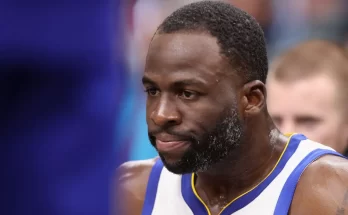“Steph Curry’s Massive Warriors Salary Makes Golden State Valkyries’ Entire WNBA Payroll Look Like a Typo”
Steph Curry’s salary with the Golden State Warriors continues to be one of the most talked-about numbers in professional sports, not only because of his immense talent and iconic status in the NBA but also due to the staggering financial gap it highlights when compared to players in the WNBA. The Golden State Valkyries, the newly introduced WNBA team based in the Bay Area, have drawn significant attention as women’s basketball continues to grow in popularity and visibility. Yet, when Curry’s contract is placed side by side with the combined salaries of the entire Valkyries roster, the comparison is so lopsided that it almost looks like a typo. This massive difference underscores the ongoing conversation about pay disparities between men’s and women’s professional sports, even as the WNBA makes strides toward greater recognition and financial stability.
Stephen Curry is one of the highest-paid athletes on the planet. His contract with the Warriors reflects not only his generational skill set but also his marketability and his central role in transforming the Warriors into a global brand. For the 2024–25 NBA season, Curry’s salary is over $50 million, making him one of the top earners in the league. The four-time NBA champion and two-time MVP has not just revolutionized the game of basketball with his three-point shooting but has also become a cornerstone of the Warriors’ sustained success. As a result, Golden State has had no problem investing heavily in its superstar, knowing that his presence on the court is worth every penny, both in terms of team performance and revenue generation through ticket sales, merchandise, and media rights.
On the other hand, the Golden State Valkyries, despite being part of the same ownership family, operate in a financial landscape that is dramatically different. The WNBA, while growing each year, is still working to close the gap in terms of TV deals, sponsorship, and ticket revenue when compared to the NBA. As a result, the salaries of WNBA players are significantly lower. Even the top players in the league make a fraction of what Curry earns in a single game. For instance, the average WNBA salary hovers around $147,000, with only a few superstars reaching salaries in the $200,000–$250,000 range. When you combine the salaries of an entire team like the Valkyries, the total payroll still doesn’t come close to touching Curry’s yearly earnings. In fact, in some cases, Curry’s game check alone could cover a substantial portion of the Valkyries’ roster.
This staggering disparity often fuels debates about the pay gap between men and women in professional sports. Critics argue that salaries are a reflection of revenue generated, and the NBA simply brings in far more money through television rights, global marketing, and ticket sales. While this is true to an extent, the conversation is more nuanced than that. Advocates for higher WNBA salaries point out that increased investment in women’s basketball — through better marketing, broadcasting opportunities, and corporate sponsorship — would help bridge the gap and grow the league’s financial footprint. The recent expansion of the WNBA, including the addition of the Golden State Valkyries, is seen as a positive step toward achieving this goal, as it signals that demand for the women’s game is on the rise.
Curry himself has often been supportive of women’s sports and has spoken publicly about the importance of recognizing female athletes. His status as a global sports icon brings attention to these comparisons, and it’s worth noting that the Warriors organization has invested significantly in launching the Valkyries as a marquee franchise in the WNBA. The team is expected to benefit from the Warriors’ infrastructure, fan base, and marketing reach. The hope is that, over time, the Valkyries will become one of the flagship teams of the league, attracting big crowds and sponsorships that can help elevate the salary structure for players.
Looking at the numbers, the contrast is almost absurd. Curry’s current salary sits around $51.9 million for the 2024–25 season. By comparison, the salary cap for an entire WNBA team is roughly $1.5 million. That means Curry earns over 30 times more than an entire roster of 12 professional women’s basketball players combined. Even when broken down on a per-game basis, Curry’s paycheck is astronomical. With an 82-game regular season, Curry makes well over $600,000 every time he steps onto the court, which is nearly five times the annual salary of an average WNBA player.
It’s not just Curry who earns salaries at this level in the NBA. The league’s superstars, including players like LeBron James, Kevin Durant, and Giannis Antetokounmpo, all have contracts that dwarf the entire payroll of a WNBA team. This is largely due to the NBA’s enormous global presence and the billions of dollars it generates annually from television deals and sponsorship agreements. The WNBA, while growing, is still far behind in terms of revenue streams. However, this does not diminish the talent or dedication of WNBA athletes, many of whom play overseas during the offseason to supplement their income.
The disparity also raises questions about public perception of value in sports. Fans of the WNBA have long argued that female athletes deserve more respect and financial recognition for their skills and the entertainment they provide. Many WNBA players are stars in their own right, representing their countries in international competition and inspiring the next generation of athletes. Yet, because the league has historically been under-promoted and underfunded, their salaries have remained modest compared to their NBA counterparts. The hope is that as new franchises like the Valkyries enter the league, the increased visibility and media coverage will lead to greater revenue sharing and higher player salaries.
Another factor that highlights the gap is endorsement deals. Curry’s income is not limited to his Warriors salary. He earns millions more through lucrative partnerships with companies like Under Armour, where he has his own signature shoe line. These endorsements often exceed his NBA salary, making him one of the highest-paid athletes in the world. By contrast, very few WNBA players have been able to secure major endorsement deals on the same scale, although this is starting to change with stars like A’ja Wilson, Breanna Stewart, and Sabrina Ionescu gaining more recognition.
The introduction of the Golden State Valkyries is seen as a game-changer for women’s basketball in the Bay Area. The team is expected to share resources with the Warriors, including access to Chase Center and state-of-the-art training facilities. This partnership could set a new standard for how NBA and WNBA franchises collaborate to grow the game for both men and women. Fans are hopeful that the Valkyries will be competitive from day one and that their presence in a sports-crazy region like the Bay Area will help increase overall attendance and interest in the league.
There is also the cultural impact to consider. The visibility of comparisons between Curry’s salary and the Valkyries’ payroll can spark conversations about equity and the value society places on women’s sports. While it’s unrealistic to expect WNBA salaries to match the NBA anytime soon due to differences in revenue, there is a growing movement to ensure that female athletes receive a fairer share of the money their sport generates. This includes better collective bargaining agreements, revenue sharing, and increased media exposure.
In the coming years, the WNBA is expected to renegotiate its television contracts and potentially bring in even more corporate sponsorships. If the league can continue its upward trajectory, the hope is that salaries will gradually rise, and players will no longer need to work year-round just to make a living wage. The success of teams like the Valkyries will play a big role in this growth, especially if they can establish a loyal fan base similar to what the Warriors have built over the past decade.
For now, the comparison between Steph Curry’s Warriors salary and the entire Valkyries roster remains a striking example of the economic divide in professional sports. It serves as both a reality check and a call to action. While Curry’s earnings are well-deserved given his impact on the game and his role in the NBA’s financial machine, the hope is that the WNBA can one day create similar opportunities for its players. With increased investment, marketing, and fan support, the league has the potential to close the gap and ensure that the next generation of women’s basketball stars are compensated in a way that reflects their talent and hard work.



